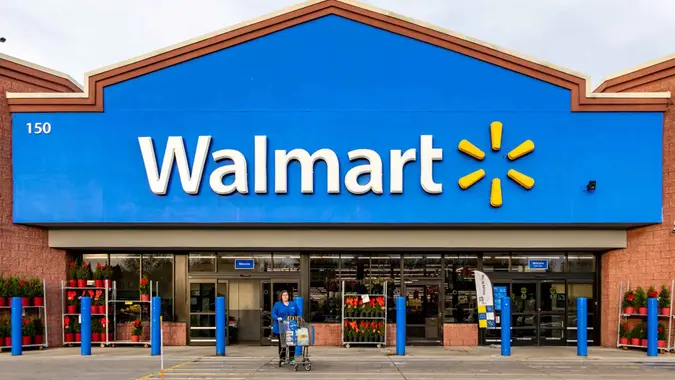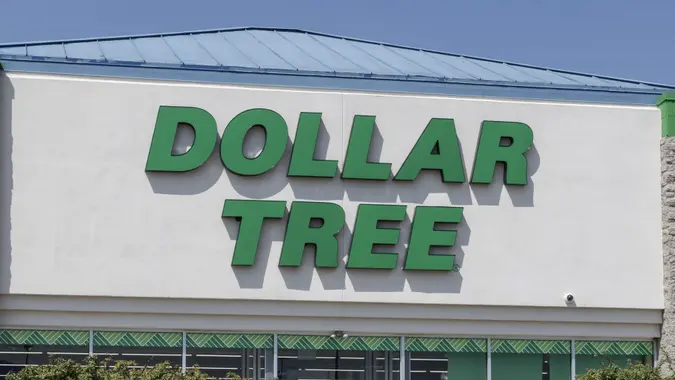How Much Cheaper Are Store-Brand Groceries Than Name Brands?

Commitment to Our Readers
GOBankingRates' editorial team is committed to bringing you unbiased reviews and information. We use data-driven methodologies to evaluate financial products and services - our reviews and ratings are not influenced by advertisers. You can read more about our editorial guidelines and our products and services review methodology.

20 Years
Helping You Live Richer

Reviewed
by Experts

Trusted by
Millions of Readers
Name-brand recognition is everything these days, even when it comes to the groceries you put in your cart. All of us have our go-to items, with packaging and labels that we’ve come to know and love. That being said, not all brands are created equal, especially when it comes to store-brand groceries versus big names in food and the price difference between the two.
Shopping the best deals on food can be quite the conundrum. Here’s a breakdown of just how much cheaper store-brands are than name brands, as well as why.
Store-Brand Popularity Is Rising
Sorry, store brands, you’ve never won the popularity contest…until recently.
According to the Private Label Manufacturers Association (PLMA), “One of every five food or non-food grocery products sold across the U.S. carries the retailer’s own brand and was supplied by a private label manufacturer. In 2021, private label sales increased by $1.9 billion in volume over the previous year. Store-brand market shares came in at 17.7% in dollars and 19.6% in units. Store brands accounted for $199 billion worth of dollar sales across all the major retail channels.”
It’s clear that consumers are opting to go for store brands now more than ever. What’s the reason behind the spike in purchasing non-name brands?
PLMA cites, “Habit, familiarity and successful mass market promotion and advertising driven by influential network TV and print newspapers were reasons shoppers were drawn to national brands a half century ago. In the internet and social media age much has changed, not the least consumers’ allegiance to big brands.”
In Some Cases, Name Brand Is the Same as Store Brand
Lot of grocery stores will offer their customers choices when it comes to purchasing a name-brand item or the same type of item that’s the store-brand version. This includes retailers such as Whole Foods, Kroger and Ralphs. But stores like Trader Joe’s have, well, only Trader Joe’s items.
Being a “trader” is actually the industry secret to Trader Joe’s success because they can afford to keep their prices lower — particularly when it comes to pantry staples — than other big grocery chains. Trader Joe’s, according to their website, doesn’t use distributors or brokers like other grocery stores. Instead, the company directly buys from growers, vendors and manufacturers.
However, the discounts don’t extend to every part of what Trader Joe’s has to offer.
As CNET notes, “The produce department at Trader Joe’s is almost entirely sold by package or by item (as opposed to by weight), with prices that rarely fluctuate, meaning that there might be better produce deals to be found at conventional retailers for fruits and vegetables that are priced by weight rather than the piece, and based on seasonality.”
Shoppers Are Smarter
More and more of us are getting smarter and savvier when we go grocery shopping. We are concerned about not only how much our food is going to cost, but also what it’s made up of and what are some health risks that might be associated with eating it. But the true detail that American consumers have always kept a close eye on is cost, especially as inflation rises and the cost of groceries goes up.
“Formerly national brand-loyal Americans are now more knowledgeable about the true value of products they buy and they are reaching instead for store brands,” the PLMA study finds. “In the process, they are building new habits and making new friends. With top quality, unique items and solid savings, store brands add up to a smarter choice for shoppers.”
The data is clear that shoppers in the United States are looking for the best deals, which usually involve a generic store brand over a fancier national one. The PLMA breaks it down that, “Using average cost per unit, in a store-wide price comparison between store brands and national brands, it is estimated that U.S. consumers save more than $40 billion a year on grocery and household purchases by opting for the store brand over the national brand version of their favorite products.”
The Bottom Line
Crunch the numbers across numerous food categories and the difference between store-brand versus name-brand groceries averages out to about 40% in total savings.
As much as big name brands spend on marketing and as much as some of us feel loyal to keep buying what we are familiar with, you could be missing out on potential savings by not purchasing a store-brand product.
So at the end of the day, it might be worth it to at least try that generic item with the grocery store label on it instead of the flashier, more well-known one. Chances are, the taste and flavor difference will be unnoticeable, but your grocery bill will thank you for taking a load off.
 Written by
Written by  Edited by
Edited by 

























